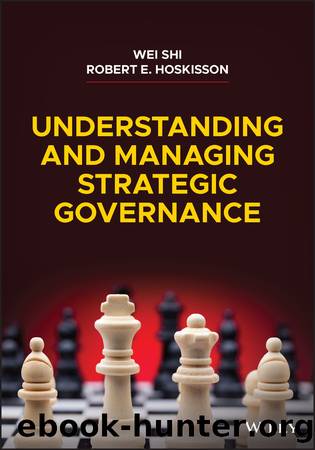Understanding and Managing Strategic Governance by Shi Wei;Hoskisson Robert E.; & Robert E. Hoskisson

Author:Shi, Wei;Hoskisson, Robert E.; & Robert E. Hoskisson [Shi, Wei & Hoskisson, Robert E.]
Language: eng
Format: epub
Publisher: John Wiley & Sons, Incorporated
Published: 2021-08-10T00:00:00+00:00
TRANSACTIONAL GOVERNANCE ACTORS WITHOUT RESOURCE PROVISION
As noted in Chapter 2, short selling can be an expensive strategy, so investors tend not to hold a short position for a long period of time. Short sellers hence have a transactional relationship with shorted firms. Also, because short sellers are motivated to drive down share prices through revealing negative information or spreading rumors, these investors are unlikely to offer firms resources that facilitate the development of a successful competitive strategy. These governance actors fall under Quadrant IV of Figure 5.1 because they have only a transactional relationship and provide no resources for strategic decisions.
Short sellers can affect strategic choices pertaining to competitive strategy, mainly because of their ability to depress stock prices. When a firm's competitive actions fail to generate anticipated benefits, the scenario can dampen its short-term financial performance and create short-selling opportunities. The threat from short sellers can in fact lead companies to refrain from undertaking a large volume of competitive actions.72 In addition, being attacked by activist short sellers can make a company vulnerable to attacks from its rivals. When activist short seller Chris Brown labeled Energous, a wireless charging company, âa worthless equityâ and claimed that Apple would not adopt the company's wireless charging technology,73 his comment created opportunities for Energous's rivals to take over its market share. For example, according to data from Capital IQ, Pioneer Power Solutions, Energous's rival, announced that it had received several large contracts two months after Brown attacked Energous.
Transient institutional investors trade in and out of portfolio firms and lack the motivation to understand the businesses of their portfolio firms. These investors are not motivated to hold direct conversations with executives; moreover, they lack the expertise to provide information that can be used in competitive strategy. Instead, transient institutional investors try to capitalize on private information that they can collect to inform their trading strategies. Given their focus on short-term financial returns, transient institutional investors can lead firms to undertake tactical competitive actions, such as price cuts and new product launches, that are effective in improving competitive position and profitability in the short run. But when firms have high levels of transient institutional investor ownership, executives will hesitate to implement complex competitive repertoires and will instead focus on a set of familiar competitive actions.74 Short sellers and transient institutional investors alike do not provide resources directly to firms in making effective competitive strategies and can instead create opportunities for rivals to attack or lead firms to focus on tactical actions that yield only short-term gains. Thus, short sellers and transient institutional investors can result in competitive disadvantage for firms. Our recommendations on addressing the adverse influence of short sellers and transient institutional investors will be discussed in the next section.
As discussed in the Strategic Governance Highlight (Box 5.2), institutional investors can influence portfolio firms' competitive strategy through common ownership, where an institutional investor hold shares of multiple rival firms. The rise of common ownership suggests that firms cannot be considered independent decision makers in the product market.
Download
This site does not store any files on its server. We only index and link to content provided by other sites. Please contact the content providers to delete copyright contents if any and email us, we'll remove relevant links or contents immediately.
Storytelling for dummies by Andrea Fontana(1474)
Effortless by Greg McKeown(1404)
The Practice by Seth Godin(1381)
Mastering Blockchain by Lorne Lantz(1376)
Blockchain Quick Reference by Paul Valencourt & Samanyu Chopra & Brenn Hill(1130)
Mastering Blockchain by Lorne Lantz & Daniel Cawrey(893)
How to Lead by David M. Rubenstein(803)
The wind in the willows by Kenneth Grahame(799)
The Ape in the Corner Office by Richard Conniff(772)
Handbook of Big Data Analytics by Unknown(694)
Social Media Engagement For Dummies by Aliza Sherman(691)
Taking Care of Yourself (HBR Working Parents Series) by Harvard Business Review(677)
FunRetrospectives: activities and ideas for making agile retrospectives more engaging by Paulo Caroli & Tainã Caetano Coimbra(675)
Getting Started with Data: The first book you should read to successfully get along with data. by Menegatti Gabriel & Team Simbiose Ventures(675)
Business Storytelling For Dummies by Unknown(651)
Evernote for Self Publishing: How to Write Your Book in Evernote from Start to Finish by Jose John(644)
Help! My Facebook Ads Suck-- by M. D. Cooper & Jill Cooper(636)
A Leader Listens by Ajay Banga(621)
Genius by Choice: Your unconventional A–Z handbook to enhance your learning process by Remondino Giulia S(621)
